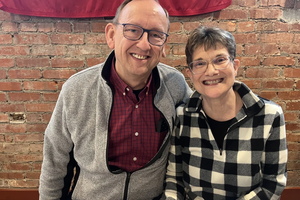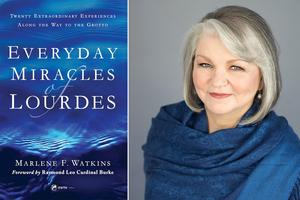National Eucharistic Congress: Moments of Extraordinary Grace
Now everything seems just a little bit different...

Editor's Note: Bishop James D. Conley wrote a reflection in light of the National Eucharistic Congress for the Southern Nebraska Register on July 25, 2024. The piece is republished here with permission.
I’m writing this column at the conclusion of the 10th National Eucharistic Congress (NEC) held in Indianapolis from Wednesday to Sunday of last week. By all accounts, it was a tremendous success. For me personally, it was one of the most moving and hopeful experiences in my 39 years as a Catholic priest. Time will tell, but I think it will be a moment of extraordinary grace for the Church here in the United States.
The 10th National Eucharistic Congress has been in the planning for nearly three years and is part of a larger three-year Eucharistic Revival launched by the U.S. bishops on the Solemnity of Corpus Christi in 2022. The Eucharistic Revival was a response to polls and surveys indicating that since the pandemic in 2020, there has been a steady decline in Sunday Mass attendance. At the heart of this decline, according to the data, has been the loss of belief in the Real Presence of Jesus in the Blessed Sacrament. The U.S. bishops were motivated to try to “revive” love, understanding and amazement in the Holy Eucharist in the hearts of anyone who would listen.
The National Eucharistic Congress in Indianapolis drew over 60,000 people, including over 150 bishops, hundreds of priests and seminarians, as well as a vast multitude of consecrated religious men and women, in addition to tens of thousands of the lay faithful in the Church, not to mention all those who participated online or via EWTN.
I have been to seven World Youth Days and a half-dozen FOCUS SEEK conferences, all of which were extraordinary moments of grace, and the Eucharistic Congress superseded them all. Whereas WYD and SEEK concentrate on youth and young adults, the NEC assembled the whole Church together, the young and the old, cleric, religious and lay, and everything in between. It was the entire Body of Christ coming together for prayer, unity and friendship in the Holy Eucharist.
From the Diocese of Lincoln, we had over 200 pilgrims who traveled to Indianapolis by car and bus. Our pilgrim group had representation from the whole diocese, from Nebraska City to North Platte, from Blue Hill to Wahoo. We had several of the “Eucharistic Passport” winners and their families, in addition to 10 priests, two newly ordained deacons, and seven of our seminarians, and a large representation of our consecrated religious sisters and brothers. It was the Church in all her beauty and diversity.
The last time there was a National Eucharistic Congress here in the United States was in 1941, over 80 years ago, so there was no recent road map of how to successfully do such a massive undertaking, especially in an age of political and ecclesial division. As far as I can tell, the Church, in all her diversity and beauty, was fully represented.
The talks included the most popular and effective speakers in the country. Every evening concluded with Eucharistic adoration in Lucas Oil Stadium (the stadium where the Indianapolis Colts play). The music was absolutely stunning: all forms, from Gregorian chant and polyphony to contemporary, and the Indianapolis Symphony provided the sacred music for the concluding Mass. His Eminence Cardinal Luis Tagle, prefect of the Dicastery for Evangelization, brought personal greetings from the Holy Father and delivered a compelling homily for the closing Mass on Sunday. His Eminence Cardinal Christophe Pierre, the papal representative to the United States, gave the opening talk and participated in the entire event.
One of my favorite features was the Exhibition Hall, where, seemingly, every Catholic apostolate, ministry, religious community, movement, product and entrepreneur was represented. Catholic cosmetics companies, financial advisors, schools and health-care ministries, to name just a few, all celebrated their unique place in the Church. It was like the City of God under one roof. It is easy to despair that it sometimes seems that the Church is barely alive, but for those who were in Indianapolis these days, it is clear that the Church is not just alive but full of life.
I am reminded of that chilling line out of C.S. Lewis’ Chronicles of Narnia when the fictional talking beaver tells the children that Aslan is on the move. The simple prospect of Aslan being among them changed the children so that everything seemed different. That is what I experienced in Indianapolis. Everything seems just a little bit different. The Church, the mystical Body of Christ, is on the move here in the United States.
The heart of the NEC was, at it should be, the liturgy, which is the source and summit of our faith. We experienced this first in the various expressions of the Church’s liturgy that were offered so beautifully, but also in the tremendous fruits of this liturgical source: the talks, praise-and-worship sessions, works of charity expressed in many forms — including the beautiful accompaniment of the homeless and their needs. Also flowing from the liturgy was the palpable community of faith among clerics, religious, consecrated and laity that spontaneously grew out of the common experience and, uniquely for me, the brotherhood of episcopal charity there felt unprecedented.
We bishops often, perhaps far too often, interact with each other as fellow administrators in the Church. In Indianapolis, we did not have business meetings; we simply prayed and worshipped with each other. If you can imagine 150-plus bishops entering into praise-and-worship music, singing together as brothers, you will get a sense of how the Holy Spirit stirred hearts. (Perhaps they put us in our own section so not to submit everyone else to our lack of musical talent.)
Ultimately, everything about the Congress was a reminder that the Blessed Sacrament is a sacrament of charity. It is the sacrament that draws us into the life of Christ, who animates our lives so that we may love as He loves.
So often, it is easy to fall into our various camps within the Church, especially left versus right, however that manifests itself. None of that existed in Indianapolis because the entire event was about drawing closer to Christ and letting Christ find us in our weakness. There was no “agenda” other than the merciful love of Christ.
Every now and then, we need to remind ourselves that we have a truly unimaginable gift of Jesus being with us in the Real Presence. Hopefully, we all make time to be with Jesus in the liturgy and in prayer before the Blessed Sacrament, and it is my hope and prayer that our efforts toward Eucharistic Revival in the Diocese of Lincoln will continue to be a source of grace for all within the diocese and beyond.
Bishop James D. Conley is the sheperd of the Diocese of Lincoln Nebraska.
A convert to the Catholic faith, he chose the same motto as the great 19th century English convert, John Henry Cardinal Newman, "cor ad cor loquitur," which means "heart speaks to heart."
- Keywords:
- eucharistic congress
- bishop james conley

















